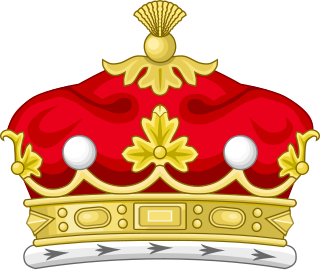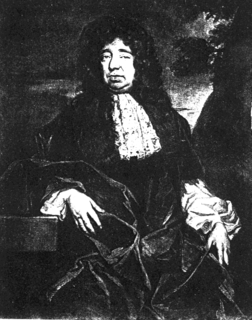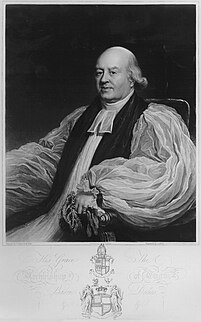Related Research Articles

Marquess of Waterford is a title in the Peerage of Ireland and the premier marquessate in that peerage. It was created in 1789 for George Beresford, 2nd Earl of Tyrone. It is presently held by Henry Nicholas de la Poer Beresford, 9th Marquess of Waterford.
The title of Viscount Mountjoy has been created three times, twice in the Peerage of Ireland and once in the Peerage of Great Britain. The creations in the Peerage of Ireland were made in 1683 and 1795, and became extinct in 1769 and 1829, respectively. The creation in the Peerage of Great Britain occurred in 1796, as a subsidiary title for the Marquess of Bute, to which title it is still attached.

Baron Dacre is a title that has been created three times in the Peerage of England, every time by writ.

Earl of Shelburne is a title that has been created two times while the title of Baron Shelburne has been created three times. The Shelburne title was created for the first time in the Peerage of Ireland in 1688 when Elizabeth, Lady Petty, was made Baroness Shelburne. She was the wife of the noted economist Sir William Petty. The title was for life only and became extinct on her death in circa 1708. On the same day that Lady Shelburne was elevated to the peerage, her eldest son by Sir William Petty, Charles Petty, was also raised to the Peerage of Ireland as Baron Shelburne. He died young in 1696, when the title became extinct. The barony was created for a third time in the Peerage of Ireland in 1699 in favour of the Hon. Henry Petty, younger son of Sir William Petty and Lady Shelburne. In 1719 he was further honoured when he was made Viscount Dunkerron and Earl of Shelburne, also in the Peerage of Ireland. On his death in 1751 these titles also became extinct.

Baron Decies, of Decies in the County of Waterford, is a title in the Peerage of Ireland. It was created in 1812 for the Right Reverend William Beresford, Archbishop of Tuam from 1794 to 1819. He was the third son of the Marcus Beresford, 1st Earl of Tyrone, and the younger brother of the George Beresford, 1st Marquess of Waterford. His son, the second Baron, married Charlotta Philadelphia Horsley, only daughter and heiress of Robert Horsley, and assumed the additional surname of Horsley in 1810. However, none of the subsequent barons have held this surname. His grandson, the fifth Baron, was a Major in the Army and also sat in the House of Lords as an Irish Representative Peer from 1912 to 1944. As of 2013 the title is held by his grandson, the seventh Baron, who succeeded his father in 1992. As a descendant of the first Earl of Tyrone he is also in remainder to that peerage and its subsidiary titles, which are now held by his kinsman the Marquess of Waterford.
Viscount Lisburne is a title that has been created twice, both times in the Peerage of Ireland. The first creation came in 1685 in favour of Adam Loftus, along with the subsidiary title of Baron of Rathfarnam. These titles became extinct upon his death in 1691 at the siege of Limerick. The second creation came in 1695 in favour of John Vaughan. For more information on this creation, see Earl of Lisburne.

Earl of Yarmouth is a title that has been created three times in British history, once in the Peerage of England and twice in the Peerage of Great Britain. The first creation came in the Peerage of England in 1679 in favour of the politician and scientist Robert Paston, 1st Viscount Yarmouth. He had already been created Baron Paston and Viscount Yarmouth in the Peerage of England in 1673. He was the son of William Paston, who had been created a Baronet, of Oxnead in the County of Norfolk, in the Baronetage of England in 1641. Lord Yarmouth was succeeded by his son, the second Earl. He notably served as Treasurer of the Household between 1687 and 1689. He had no surviving male issue and the titles became extinct on his death in 1732.

Earl of Londonderry is a title that has been created three times in the Peerage of Ireland. The first creation came in 1622 in favour of Thomas Ridgeway, 1st Baron Ridgeway, who served as Treasurer of Ireland and was involved in the colonisation of Ulster. He had already been created a Baronet, of Torrington in the County of Devon, in 1611, Lord Ridgeway, Baron of Gallen-Ridgeway, in the Peerage of Ireland, in 1616, and was made Viscount Gallen-Ridgeway at the same time as he was granted the earldom, also in the Peerage of Ireland. The titles became extinct on the death of his great-grandson, the fourth Earl, in 1714.
Earl of Feversham is a title that has been created three times, once in the Peerage of England, once in the Peerage of Great Britain and once in the Peerage of the United Kingdom. All three creations are now extinct.
Baron Nugent is a title that has been created three times, twice in the Peerage of Ireland and once in the Peerage of the United Kingdom. All three creations are extinct. The first creation came in the Peerage of Ireland in 1767 in favour of Robert Craggs-Nugent, who was made Viscount Clare at the same time. In 1776 he was further honoured when he was made Earl Nugent. For further history of this creation, see Earl Nugent and Viscount Cobham. The second creation came in the Peerage of Ireland in 1800 when Mary, Marchioness of Buckingham, was made Baroness Nugent, of Carlanstown in the county of Westmeath, with remainder to her second son Lord George Nugent-Grenville. She was the daughter of the first Earl Nugent and the wife of George Nugent-Temple-Grenville, 1st Marquess of Buckingham. She was succeeded according to the special remainder by her younger son, Lord George, the second Baron. The title became extinct on his death in 1850. The third creation came in the Peerage of the United Kingdom on 22 August 1960 when Terence Nugent was made Baron Nugent, of West Harling in the county of Norfolk. This creation became extinct on his death in 1973.
Viscount Lanesborough is a title that has been created twice in the Peerage of Ireland. The first creation came on 31 July 1676 in favour Sir George Lane, 2nd Baronet. The titles became extinct upon the death of his son, the second Viscount, on 2 August 1724. The Lane Baronetcy, of Tulske in the County of Roscommon, had been created in the Baronetage of Ireland on 9 February 1661 for Richard Lane. The second creation came on 12 August 1728 in favour Brinsley Butler, 2nd Baron Newtown-Butler. His son Humphrey was created Earl of Lanesborough in 1756. See the latter title for more information on this creation.
Baron Stuart de Decies, of Dromana within the Decies in the County of Waterford, was a title in the Peerage of the United Kingdom. It was created in 1839 for Henry Villiers-Stuart, Member of Parliament for County Waterford and Banbury and Lord-Lieutenant of County Waterford. He was the eldest son of Lord Henry Crichton-Stuart, third son of John Stuart, 1st Marquess of Bute. His mother was Lady Gertrude Emilia, daughter of George Mason-Villiers, 2nd Earl Grandison. There was uncertainty over the validity of his marriage and his son Henry Villiers-Stuart was not allowed to succeed in the title, which became extinct on his death in 1874.
Viscount Mount Cashell was a title that was created twice in the Peerage of Ireland. The first creation came in 1706 in favour of Paul Davys. He was made Baron Mount Cashell at the same time, also in the Peerage of Ireland. The titles became extinct on the death of the third Viscount in 1736. The second creation came in 1766 in favour of Stephen Moore. For more information on this creation, see Earl Mount Cashell.

William Beresford, 1st Baron Decies was an Anglo-Irish clergyman.
Baron La Poer, de la Poer, or Le Pour, is a title in the Peerage of Ireland held by the Marquess of Waterford. Its creation is the sole instance in the law of the Kingdom of Ireland recognising a peerage by writ.
Katherine FitzGerald, suo jure Viscountess Grandison, was a wealthy Irish heiress, being the only child of Sir John FitzGerald of Dromana, County Waterford. She inherited the Dromana estate in 1664 upon the death of her father. She was married three times; firstly to John Le Poer, 2nd Earl of Tyrone; secondly to Brigadier-General, Hon. Edward FitzGerald-Villiers; and thirdly and lastly to General William Steuart.
Sir Gerald Fitzgerald, 3rd Lord Decies was the son of John Fitzgerald and Ellen, daughter of Maurice FitzGibbon, the White Knight, and was the third of the Lords of Decies.
Richard Power, 1st Earl of Tyrone (1630–1690) was an Irish Jacobite nobleman.

Curraghmore near Portlaw, County Waterford, Ireland, is a historic house and estate and the seat of the Marquess of Waterford. The estate was part of the grant of land made to Sir Roger le Puher by Henry II in 1177 after the Anglo-Norman invasion of Wales.